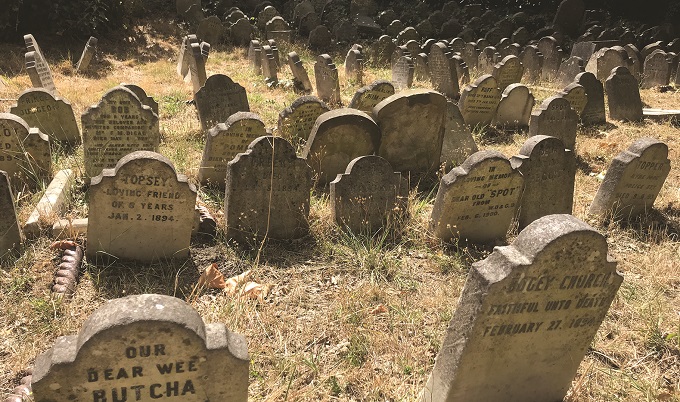Pet cemeteries
Pet cemeteries reveal rise of belief in pet afterlife
Published on: 27 October 2020
Analysis of pet cemeteries by a Newcastle University academic suggests that belief in a pet afterlife has risen since the Victorian era.
Pets as family members
Whilst many have explored changing social trends with human cemeteries, few archaeologists have studied the animal equivalent. Dr Eric Tourigny examined the graves at pet cemeteries in Newcastle and London over 100 years—starting with the opening of the first public pet cemetery in 1881.
His analysis, published in the journal Antiquity, revealed significant changes in our attitudes towards pets during this period, with more recent graves featuring a greater number of references to owners being reunited with their pets. In the Victorian era, pets were more often referred to as companions or friends but later burials treated the animals like family members.
“References to animals as family members increase after the Second World War, coinciding with a rise in the use of family surnames on pet gravestones,” Dr Tourigny says. “Some early adopters of surnames put them in parentheses or quotation marks, as if to acknowledge they are not full members of the family.”
Part of this hesitancy to acknowledge pets as family members may stem from conflict between personal feelings towards the animals and social norms. For instance, research on pet cemeteries in Scandanavia has noted many inscriptions are emotionless, which seems at odds with the care that went into creating pet memorials. “The need to express grief following the loss of a beloved animal, however, was at odds with socially acceptable beliefs of the time,” adds Dr Tourigny.

Pet afterlife
Another trend documented in the research was an increasing belief in a pet afterlife. “Few 19th-century gravestones reference an afterlife, although some may ‘hope’ to see their loved ones again,” said Dr Tourigny. “By the mid-20th century, a greater proportion of animal gravestones suggesting owners were awaiting a reunion in the afterlife.”
However, one thing that did not change is how people perceive death, with it being viewed as sleep-like throughout the entire study period. “Society’s attitudes towards death have changed little, as the sleep metaphor is used continuously throughout the twentieth century,” explains Dr Tourigny.
The first public pet cemetery was established in the UK in 1881 when the owner of a recently deceased dog called Cherry asked the gatekeeper of Hyde Park if they could be buried there. The dog was buried in the gatekeeper’s personal garden and over the next few decades, hundreds of other dogs were also interred. Public pet cemeteries subsequently spread across Britain. This research focused on four such sites: the original Hyde Park cemetery, The People’s Dispensary for Sick Animals cemetery in Ilford, and Jesmond Dene and Northumberland Park in Newcastle. Dr Tourigny documented more than 1,000 animal headstones spanning a century of burials—from their founding in the 1880s through to the 1980s.
This research reveals how pet cemeteries can provide a unique insight into the past and the people who lived in it. It shows how our relationship with pets has evolved with, and sometimes come into conflict with, social norms during the past century. The Royal Parks and Dr Tourigny will be providing a free virtual tour of the Hyde Park pet cemetery on Wednesday 28 October.
Reference: ‘Do all dogs go to heaven? Tracking human-animal relationships through the archaeological survey of pet cemeteries’ Eric Tourigny https://doi.org/10.15184/aqy.2020.191
Press release adapted with thanks to Antiquity.



